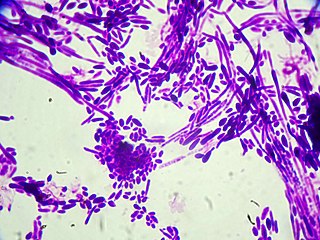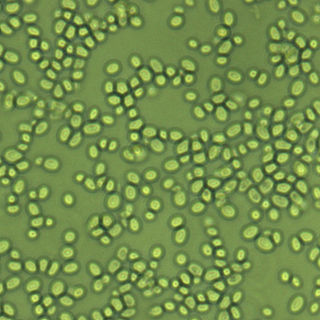
Frank C. Odds was an English mycologist. He studied Candida albicans, establishing how modern researchers study fungal pathogens and the diseases they cause. [1]

Frank C. Odds was an English mycologist. He studied Candida albicans, establishing how modern researchers study fungal pathogens and the diseases they cause. [1]
Frank C. Odds was born in Devon, England on August 29, 1945. He studied biochemistry and obtained his undergraduate degree and PhD at the University of Leeds. [2] From 1970 to 1972, Odds was a visiting Fellow at the Center for Disease Control (CDC). [1] Returning to the United Kingdom in 1972, Odds accepted a postdoctoral fellowship position back at the University of Leeds until 1975. Odds experienced his first faculty role at the University of Leicester as a lecturer and senior lecture in Medical Microbiology until 1989. After his time at the University of Leicester, Odds became the Director of Bacteriology & Mycology of the Janssen Research Foundation until 1999. His final academic role was Professor of Medical Mycology at the University of Aberdeen before retiring in 2009. [1] Odds died July 7, 2020.
Before DNA typing methods replaced the phenotypic approach, Odds created a method for biotyping Candida albicans and it became adopted internationally in many labs. [1] Odds also used Multi-Locus Sequence Typing (MLST) to determine the population structure of Candida albicans and other Candida species which allowed for virulence factors to be explored across different phylogenetic groups. [1] His breakthrough in MLST allowed Odds to serve as the curator of the Candida MLST for years. During this time, two new Candida species were discovered. The efforts of Odds allowed for further understanding of the cellular and molecular basis of the development of cell shape in C. albicans as well as help publish the first sequence of a Candida protease gene. Odds also helped invent an infection model that promoted rapid evaluation of the relative virulence or Candida strains and mutants. [1]
During Odds' time as the Director of Bacteriology & Mycology at the Janssen Research Foundation, his efforts helped develop azole and triazole antifungals. Odds had 18 patents to his name and he served as the chief coordinator on the reports of clinical trials, case reports of antifungal agents, and copious international studies. [1]
Before his death in 2020, Odds helped establish the Aberdeen Fungal Group which has gone on to become a presence in medical mycology, be part of cross-institutional collaborations around the United Kingdom, help train researchers in low income countries, and be awarded the Medical Research Council (MRC) MRC Centre status for Medical Mycology. [3]
Odds held many community roles throughout his life, including: [1]
He also received the following awards and honors: [1]
Odds published more than 500 journal articles, including: [4]

Candidiasis is a fungal infection due to any type of Candida. When it affects the mouth, in some countries it is commonly called thrush. Signs and symptoms include white patches on the tongue or other areas of the mouth and throat. Other symptoms may include soreness and problems swallowing. When it affects the vagina, it may be referred to as a yeast infection or thrush. Signs and symptoms include genital itching, burning, and sometimes a white "cottage cheese-like" discharge from the vagina. Yeast infections of the penis are less common and typically present with an itchy rash. Very rarely, yeast infections may become invasive, spreading to other parts of the body. This may result in fevers along with other symptoms depending on the parts involved.

Candida dubliniensis is a fungal opportunistic pathogen originally isolated from AIDS patients. It is also occasionally isolated from immunocompetent individuals. It is a dimorphic yeast of the genus Candida, very closely related to Candida albicans but forming a distinct phylogenetic cluster in DNA fingerprinting. It is most commonly isolated from oral cavities, and is also occasionally found in other anatomical sites.

Candida albicans is an opportunistic pathogenic yeast that is a common member of the human gut flora. It can also survive outside the human body. It is detected in the gastrointestinal tract and mouth in 40–60% of healthy adults. It is usually a commensal organism, but it can become pathogenic in immunocompromised individuals under a variety of conditions. It is one of the few species of the genus Candida that causes the human infection candidiasis, which results from an overgrowth of the fungus. Candidiasis is, for example, often observed in HIV-infected patients. C. albicans is the most common fungal species isolated from biofilms either formed on (permanent) implanted medical devices or on human tissue. C. albicans, C. tropicalis, C. parapsilosis, and C. glabrata are together responsible for 50–90% of all cases of candidiasis in humans. A mortality rate of 40% has been reported for patients with systemic candidiasis due to C. albicans. By one estimate, invasive candidiasis contracted in a hospital causes 2,800 to 11,200 deaths yearly in the US. Nevertheless, these numbers may not truly reflect the true extent of damage this organism causes, given new studies indicating that C. albicans can cross the blood–brain barrier in mice.

An antifungal medication, also known as an antimycotic medication, is a pharmaceutical fungicide or fungistatic used to treat and prevent mycosis such as athlete's foot, ringworm, candidiasis (thrush), serious systemic infections such as cryptococcal meningitis, and others. Such drugs are usually obtained by a doctor's prescription, but a few are available over the counter (OTC).

Candida is a genus of yeasts and is the most common cause of fungal infections worldwide. Many species are harmless commensals or endosymbionts of hosts including humans; however, when mucosal barriers are disrupted or the immune system is compromised they can invade and cause disease, known as an opportunistic infection. Candida is located on most mucosal surfaces and mainly the gastrointestinal tract, along with the skin. Candida albicans is the most commonly isolated species and can cause infections in humans and other animals. In winemaking, some species of Candida can potentially spoil wines.

Terconazole is an antifungal drug used to treat vaginal yeast infection. It comes as a lotion or a suppository and disrupts the biosynthesis of fats in a yeast cell. It has a relatively broad spectrum compared to azole compounds but not triazole compounds. Testing shows that it is a suitable compound for prophylaxis for those that suffer from chronic vulvovaginal candidiasis.
Candida parapsilosis is a fungal species of yeast that has become a significant cause of sepsis and of wound and tissue infections in immunocompromised people. Unlike Candida albicans and Candida tropicalis, C. parapsilosis is not an obligate human pathogen, having been isolated from nonhuman sources such as domestic animals, insects and soil. C. parapsilosis is also a normal human commensal and it is one of the fungi most frequently isolated from human hands. There are several risk factors that can contribute to C. parapsilosis colonization. Immunocompromised individuals and surgical patients, particularly those undergoing surgery of the gastrointestinal tract, are at high risk for infection with C. parapsilosis. There is currently no consensus on the treatment of invasive candidiasis caused by C. parapsilosis, although the therapeutic approach typically includes the removal of foreign bodies such as implanted prostheses and the administration of systemic antifungal therapy. Amphotericin B and Fluconazole are often used in the treatment of C. parapsilosis infection.

Candida glabrata is a species of haploid yeast of the genus Candida, previously known as Torulopsis glabrata. Despite the fact that no sexual life cycle has been documented for this species, C. glabrata strains of both mating types are commonly found. C. glabrata is generally a commensal of human mucosal tissues, but in today's era of wider human immunodeficiency from various causes, C. glabrata is often the second or third most common cause of candidiasis as an opportunistic pathogen. Infections caused by C. glabrata can affect the urogenital tract or even cause systemic infections by entrance of the fungal cells in the bloodstream (Candidemia), especially prevalent in immunocompromised patients.

Gliotoxin is a sulfur-containing mycotoxin that belongs to a class of naturally occurring 2,5-diketopiperazines produced by several species of fungi, especially those of marine origin. It is the most prominent member of the epipolythiopiperazines, a large class of natural products featuring a diketopiperazine with di- or polysulfide linkage. These highly bioactive compounds have been the subject of numerous studies aimed at new therapeutics. Gliotoxin was originally isolated from Gliocladium fimbriatum, and was named accordingly. It is an epipolythiodioxopiperazine metabolite.

Echinocandins are a class of antifungal drugs that inhibit the synthesis of β-glucan in the fungal cell wall via noncompetitive inhibition of the enzyme 1,3-β glucan synthase. The class has been termed the "penicillin of antifungals," along with the related papulacandins, as their mechanism of action resembles that of penicillin in bacteria. β-glucans are carbohydrate polymers that are cross-linked with other fungal cell wall components, the fungal equivalent to bacterial peptidoglycan. Caspofungin, micafungin, and anidulafungin are semisynthetic echinocandin derivatives with limited clinical use due to their solubility, antifungal spectrum, and pharmacokinetic properties.

Dimorphic fungi are fungi that can exist in the form of both mold and yeast. This is usually brought about by change in temperature and the fungi are also described as thermally dimorphic fungi. An example is Talaromyces marneffei, a human pathogen that grows as a mold at room temperature, and as a yeast at human body temperature.
Pathogenic fungi are fungi that cause disease in humans or other organisms. Approximately 300 fungi are known to be pathogenic to humans. Markedly more fungi are known to be pathogenic to plant life than those of the animal kingdom. The study of fungi pathogenic to humans is called "medical mycology". Although fungi are eukaryotic, many pathogenic fungi are microorganisms. The study of fungi and other organisms pathogenic to plants is called plant pathology.

A blastoconidium is an asexual holoblastic conidia formed through the blowing out or budding process of a yeast cell, which is a type of asexual reproduction that results in a bud arising from a parent cell. The production of a blastoconidium can occur along a true hyphae, pseudohyphae, or a singular yeast cell. The word "conidia" comes from the Greek word konis and eidos, konis meaning dust and eidos meaning like. The term "bud" comes from the Greek word blastos, which means bud. Yeasts such as Candida albicans and Cryptococcus neoformans produce these budded cells known as blastoconidia.

Pneumocandin B0, also known as pneumocandin B0, pneumocandin B(0), and hydroxy echinocandin, is an organic chemical compound with the formula C50H80N8O17, produced by the fungus Glarea lozoyensis.

Neil Andrew Robert Gow is a professor of Microbiology and deputy Vice Chancellor at the University of Exeter. Previously he served at the University of Aberdeen for 38 years and retains an honorary Chair there.
Graham William Gooday (1942–2001) was a British molecular biologist. He was Professor of Microbiology at Aberdeen University. He was presented with the inaugural Fleming Prize Lecture for the Microbiological Society in 1976. He served as Director of the Institute of Marine Biology.
Invasive candidiasis is an infection (candidiasis) that can be caused by various species of Candida yeast. Unlike Candida infections of the mouth and throat or vagina, invasive candidiasis is a serious, progressive, and potentially fatal infection that can affect the blood (fungemia), heart, brain, eyes, bones, and other parts of the body.
Beatrice B. "Bebe" Magee is an American biochemist and geneticist with expertise in molecular mycology and fungal genetics. She earned her B. A. in chemistry from Brandeis University in 1962 and her M. A. in biochemistry from the University of California, Berkeley, in 1964. She has been co-author on over 40 publications in peer-reviewed journals and an invited speaker at scientific meetings including Woods Hole and Cold Spring Harbor courses as well as at professional mycology societies.
Carol Kumamoto is an American microbiologist who is Professor of Molecular Biology & Microbiology at Tufts University. She investigates the filamentous growth of Candida albicans, a fungal pathogen that causes several diseases. She is also interested in how C. albicans interacts with its host during colonisation and invasive diseases. She is a Fellow of the American Association for the Advancement of Science and the American Academy of Microbiology.

Mihai G. Netea is a Romanian Dutch physician and professor at Radboud University Nijmegen, specialized in infectious disease, immunology, and global health.